Balanced Diet! Hey there, cat lovers! If you’ve ever found yourself puzzled by the vast array of cat food options or wondered about the best diet to keep your kitty purring with health, you’re not alone. Nutrition plays a pivotal role in ensuring our feline friends lead long and happy lives, but cat nutrition can sometimes feel like a complex puzzle. Cats have specific dietary needs that differ significantly from other pets, thanks to their unique evolutionary history. In this guide, we’ll dive into the essentials of creating a balanced diet for your cat, exploring everything from the must-have nutrients to choosing the right food for every stage of their life. So, whether you’re a seasoned cat owner or a new cat parent, let’s unlock the secrets to a perfectly tailored diet that will keep your cat healthy and vibrant!
Understanding Cat Nutrition Basics

When it comes to feeding our feline friends, it’s not just about giving them whatever leftovers we have from dinner or a random pick off the pet food aisle. Cats have specific nutritional needs that must be met to keep them in top shape. Let’s break down what makes up a cat’s diet and why these elements are so crucial.
Essential Nutrients
First off, every cat needs a combination of several key nutrients: proteins, fats, vitamins, and minerals. These aren’t just arbitrary; they’re the building blocks of your cat’s health. Protein, for example, should be the star of their diet, as it supports everything from muscle maintenance to a shiny coat.
Why Cats Need High Protein
Cats are obligate carnivores, which means in the wild, their diet would consist almost entirely of meat. Domestic cats haven’t strayed far from their ancestors in this regard, requiring a diet high in animal proteins to thrive. Proteins are vital for their energy and overall well-being, so skimping on this can lead to health issues down the line.
Unique Dietary Needs
One of the most fascinating aspects of cat nutrition is their need for specific nutrients that other pets don’t require. Take taurine, for example—an amino acid found only in animal-based proteins. Taurine is absolutely essential for your cat’s heart health, vision, and reproduction. Unlike dogs or humans, cats can’t make enough taurine on their own and need a dietary source to avoid serious health problems.
Understanding these basics isn’t just about filling the bowl; it’s about crafting a diet that mimics what nature intended for optimal feline health. This foundation not only supports their physical health but also ensures they remain lively and affectionate companions for years to come. Let’s use this knowledge as we explore more about what to feed them in the next sections!
Evaluating Commercial Cat Foods

Choosing the right commercial cat food can seem like navigating a minefield with all the options out there. But don’t worry! Understanding what to look for can simplify this process tremendously and ensure you’re providing the best possible nutrition for your feline friend. Let’s dive into how you can become a savvy shopper when picking out your cat’s meals.
Types of Cat Food
First, let’s look at the different types of cat food available:
- Wet Food: This option is great for hydration since it’s high in moisture content, which can be particularly beneficial for cats that don’t drink enough water on their own. It’s often more palatable and closer to their natural diet in texture.
- Dry Food: Convenient and cost-effective, dry food can be left out for free-feeding without the risk of spoilage. However, it’s low in moisture and can contribute to dehydration if not balanced with other water sources.
- Semi-Moist Food: A middle ground between wet and dry, semi-moist foods are less common but can be a good treat or occasional meal.
Reading Labels
When you’re looking at cat food labels, it’s like reading a nutrition label for your own food. You want to check for a few key things:
- Protein Source: Look for foods where a named animal protein (like chicken, beef, or fish) is listed first, indicating it’s the main ingredient.
- By-products and Fillers: While some by-products can be nutritious, it’s generally better to choose foods with fewer fillers like corn and wheat, which offer less nutritional value.
- AAFCO Statement: Foods that meet the AAFCO (Association of American Feed Control Officials) guidelines will have a statement assuring that the food provides complete and balanced nutrition.
Important Ingredients and Additives
Lastly, it’s important to know which ingredients are beneficial and which to avoid:
- Beneficial Ingredients: These include high-quality animal proteins, essential fatty acids, and fibers that aid digestion.
- Additives to Avoid: Be wary of artificial colors, flavors, and preservatives such as BHA, BHT, and ethoxyquin, which can be harmful over time.
By understanding these elements, you can make informed choices about what commercial foods will nourish your cat effectively. Remember, the goal is to mimic a natural diet as much as possible, supporting their health from the inside out. Next, we’ll explore the intriguing world of raw and homemade diets for those considering a more hands-on approach to their cat’s nutrition.
The Role of Raw and Homemade Diets

As pet parents seek to provide the most natural and healthy options for their feline friends, raw and homemade diets have surged in popularity. These diets aim to replicate what cats would naturally eat in the wild, but they come with their own set of considerations. Let’s dig into what these diets involve and how to manage them safely.
Pros and Cons of a Raw Diet
Raw diets typically consist of uncooked meat, bones, and organs, mirroring the prey a cat might hunt. Here’s what to weigh up:
- Pros:
- Natural Eating Habits: Feeding raw can align closely with a cat’s natural dietary preferences and digestive system.
- Improved Health Markers: Some owners report better dental health, shinier coats, and more energy in their cats on raw diets.
- Cons:
- Health Risks: Raw diets can harbor pathogens like salmonella and E. coli, which can be risky for both pet and human health.
- Nutritional Balance: It can be challenging to ensure the diet is nutritionally complete, which is crucial for preventing deficiencies.
Designing a Homemade Diet
For those who prefer more control over their cat’s diet, homemade meals are an option. However, it’s important to design these diets with care:
- Consult a Vet or Nutritionist: Always work with a professional to create recipes that meet all of your cat’s nutritional needs.
- Balanced Ingredients: A well-rounded homemade diet should include the right proportions of protein, fats, and essential nutrients.
- Supplements: Often, supplements are necessary to fill in nutritional gaps, especially taurine, which is critical for cats and not found in over-the-counter meats.
Safety Considerations
Whether you choose raw or homemade, safety is paramount:
- Proper Handling and Storage: Raw meat should be handled with strict hygiene to prevent contamination. Store it at safe temperatures to minimize bacterial growth.
- Transition Slowly: If switching from commercial to raw or homemade, introduce the new food gradually to avoid digestive upset.
- Regular Health Checks: Monitor your cat’s health closely when switching diets to catch any potential nutritional deficiencies early.
Exploring raw and homemade diets can be a rewarding way to cater to your cat’s nutritional needs, but it requires a thoughtful and informed approach. Next, we’ll cover special dietary considerations for different life stages and health conditions, ensuring your cat stays healthy at every age.
Special Dietary Considerations

Cats, much like people, have varying nutritional needs depending on their age, health, and lifestyle. Tailoring your cat’s diet to accommodate these factors can significantly enhance their well-being and help manage any health issues that may arise. Let’s delve into how to adjust your cat’s diet to fit their specific needs.
Life Stage Nutrition
- Kittens: These little bundles of energy require diets rich in protein and calories to support their rapid growth and development. Ensure the food is specifically formulated for kittens, providing all the necessary nutrients in the right balances.
- Adult Cats: Maintenance is the goal here, with a balanced diet that prevents weight gain while sustaining their daily energy needs. Portion control is crucial as their metabolism begins to stabilize.
- Senior Cats: Older cats may need lower-calorie diets to help maintain a healthy weight as their activity levels decrease. They might also benefit from increased fiber and supplements to support joint health and renal function.
Managing Health Issues Through Diet
- Obesity: This is a common issue that can lead to other serious health problems in cats. Diets with higher protein and lower fat, coupled with carefully measured portions, can help manage weight effectively.
- Diabetes: Cats with diabetes benefit from diets low in carbohydrates and high in protein, which can help regulate blood sugar levels.
- Kidney Disease: For cats dealing with kidney issues, reduced protein, low phosphorus, and non-acidifying foods are often recommended to decrease the workload on the kidneys.
Allergies and Sensitivities
- Identifying Allergens: If your cat shows signs of allergies (like itching, gastrointestinal upset, or chronic infections), consult your vet. They might recommend an elimination diet to identify the culprits.
- Hypoallergenic Diets: These diets are crafted to minimize the risk of allergic reactions. They use protein sources that the cat has never eaten before, as novel proteins are less likely to trigger allergies.
Adjusting your cat’s diet according to these specific needs not only promotes their overall health but can also prevent and manage common health conditions. With a mindful approach and perhaps some guidance from your vet, you can ensure your cat enjoys a happy, healthy life at every stage. Up next, we’ll explore supplements and functional foods that can add that extra nutritional punch to your cat’s diet.
Supplements and Functional Foods

While a well-balanced diet should provide most of the nutrients your cat needs, there are situations where supplements and functional foods can play a beneficial role in enhancing your cat’s health. Let’s explore when supplements might be necessary, how to choose the right ones, and the role of innovative functional foods in a feline diet.
When Supplements Are Needed
Supplements can be helpful in several scenarios:
- Nutritional Gaps: Even the best commercial diets might not cater to every individual cat’s needs, especially those with specific health conditions.
- Age-Related Needs: Older cats, or those with certain health issues like joint stiffness, might benefit from supplements such as glucosamine or omega-3 fatty acids.
- Support for Illness Recovery: Cats recovering from illness or surgery can benefit from additional vitamins and minerals to boost their immune system and aid in their recovery.
Choosing the Right Supplements
Selecting the appropriate supplements is crucial for ensuring they benefit your cat without causing harm:
- Veterinarian Recommendation: Always consult with your veterinarian before adding any supplements to your cat’s diet to avoid overdosing or interactions with other medications.
- High-Quality Brands: Opt for supplements from reputable brands that have been verified for safety and efficacy.
- Appropriate Formulations: Ensure the supplement is specifically formulated for cats, as their needs differ significantly from other pets and especially from humans.
Innovative Functional Foods
The world of pet food is always evolving, and functional foods are at the forefront of this innovation. These are foods enhanced with additional health benefits:
- Probiotics: Live beneficial bacteria can help maintain the health of your cat’s digestive system, improving nutrient absorption and bowel health.
- Omega Fatty Acids: Foods fortified with omega-3 and omega-6 fatty acids can promote better skin and coat health, along with reducing inflammation.
- Antioxidants: These can be included in a cat’s diet to help combat oxidative stress and enhance immune function, which is particularly beneficial for aging cats.
Integrating supplements and functional foods into your cat’s diet can provide targeted nutritional support and address specific health issues. However, it’s important to proceed with guidance from your vet to tailor these additions effectively and safely to your cat’s unique health profile. In our next section, we will provide practical feeding tips to help integrate these strategies into your daily routine, ensuring your cat not only survives but thrives.
Practical Feeding Tips
Once you’ve tailored the perfect diet for your feline friend, incorporating practical feeding practices will ensure they receive the optimal benefit from their meals. Here are some tips to help you establish a healthy and effective feeding routine for your cat.
Feeding Routines
Establishing a consistent feeding schedule helps regulate your cat’s digestion and prevents overeating:
- Set Meal Times: Cats often thrive on routine. Feeding them at the same times each day can help prevent anxiety and reduce begging behaviors.
- Controlled Portions: Measure food portions based on your cat’s weight, age, and activity level to maintain a healthy weight. Your vet can help determine the right amount.
Portion Control
Managing how much your cat eats is crucial, especially in preventing and managing weight issues:
- Use Measuring Cups: Always use a measuring cup to serve the correct amount of food, rather than guessing.
- Adjust as Needed: Be responsive to your cat’s health and activity changes by adjusting food portions accordingly, which may require regular consultations with your vet.
Interpreting Cat’s Feedback
Cats communicate their satisfaction or displeasure with their diets in various ways, so paying attention to their feedback is key:
- Monitor Eating Habits: Keep an eye on how eagerly your cat approaches their food and how much they consume. A sudden loss of appetite could indicate health issues.
- Watch for Digestive Reactions: Changes in your cat’s bowel movements or signs of distress after eating certain foods might suggest dietary intolerances or allergies.
- Observe Behavioral Changes: Behavioral changes can also signal dissatisfaction with their diet or emerging health problems.
Implementing these feeding practices isn’t just about following rules; it’s about adapting to the unique needs and preferences of your cat. By establishing a consistent routine and being attentive to your cat’s feedback, you can ensure they remain healthy and happy. Remember, the ultimate goal is to provide a diet that supports your cat’s well-being and vitality through all stages of life. This commitment to their nutrition will pay off in countless ways, enhancing both their quality of life and your relationship with them.
Conclusion
Crafting the perfect diet for your cat is both an art and a science. From understanding the basics of feline nutrition to selecting the right commercial foods, considering raw or homemade options, and adjusting diets based on specific health needs, every step you take is crucial for your cat’s overall well-being. Remember, what works for one cat might not work for another, highlighting the importance of personalized nutrition.
As we wrap up this guide, here are a few key takeaways:
- Consult Your Veterinarian: Regular consultations with your vet are invaluable. They can provide guidance tailored to your cat’s specific health conditions, life stage, and dietary needs.
- Be Observant: Always be attentive to how your cat reacts to their diet. Changes in appetite, behavior, or physical condition can offer important clues about their health and the suitability of their diet.
- Stay Informed: The world of pet nutrition is ever-evolving. Staying informed about the latest research and trends in cat food can help you make better choices for your furry friend.
By prioritizing a balanced diet, you’re not just filling your cat’s bowl; you’re enhancing their quality of life and potentially extending it. So, take the time to invest in their nutrition—it’s one of the most loving things you can do for your cat. Whether you choose commercial foods, explore raw options, or cook homemade meals, your efforts to maintain their health through diet will strengthen your bond and bring you joy as you watch them thrive.
Remember, a well-balanced diet is key to a happy, healthy cat. Here’s to many joyful years together with your well-nourished feline friend!


